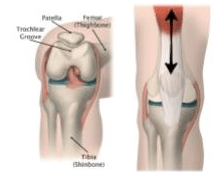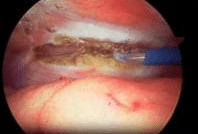Authored by: David C. Buck, M.D. - Orthopedic Surgeon and Sports Medicine Specialist at MD West ONE (Omaha and Fremont, Nebraska)
What is Patellofemoral Pain Syndrome (PFPS)?
Patellofemoral pain syndrome (PFPS) is a broad term used to describe pain in the front of the knee and around the patella (kneecap). The pain and stiffness caused by PFPS can make it difficult to climb stairs, kneel down, and perform other everyday activities. This condition is often seen in younger athletes secondary to growth changes coupled with advanced and more rigorous athletic activities.
The patella normally rests in a small groove at the end of the femur called the trochlear groove. As you bend and straighten your knee, the patella slides up and down within the groove.
What are the causes Patellofemoral Pain Syndrome (PFPS)?
Overuse
In most cases, PFPS is caused by vigorous physical activities that put repeated stress on the knee. It can also be caused by a sudden change in physical activity, which can be related to the frequency of intensity of the activity.
Other factors that may contribute to patellofemoral pain include:
- Use of improper sports training techniques or equipment
- Changes in footwear or playing surface (e.g., natural grass field to artificial turf)
Patella Malalignment
This condition can also be caused by abnormal tracking of the patella in the trochlear groove (end of thigh bone in which the patella tracks). In this condition, the patella is pushed laterally to the outside of the groove when the knee is bent. This abnormality may cause increased pressure between the back of the patella and the trochlea leading to pain and inflammation. Overtime the outside tissue along the patella (retinaculum) can become tight and lead to maltracking of the kneecap in the groove. Factors that contribute to poor tracking of the kneecap include growth changes leading to anatomical changes in the knee, hip, and thigh as well as muscular imbalances or weakness involving the hip and thigh. We often see this in younger athletes in their peak growth period during adolescence.

(Left) The patella normally rests in a small groove at the end of the femur called the trochlear groove. (Right) As you bend and straighten your knee, the patella slides up and down within the groove.
What are the symptoms of Patellofemoral Pain Syndrome (PFPS)?
The most common symptom of PFPS is a dull, aching pain in the front of the knee. This pan can begin gradually and is frequently activity-related. Symptoms can include pain during exercise, pain after prolonged periods of sitting, pain related to a change in activity, or catching/clicking in the front of the knee with activities.
How do we evaluate a patient with Patellofemoral Pain Syndrome (PFPS)?
I will begin with a physical examination in the office to include x-rays. The goal of that exam is to rule out other issues in the knee that can also cause pain (meniscal cartilage and ligament tears or instability for example). An MRI may be ordered if your symptoms do not improve with physical therapy and home exercise over time.
What are the treatments for a patient with Patellofemoral Pain Syndrome (PFPS)?
Nonsurgical Treatment:
We will typically begin with ice, rest, activity modifications if needed, and possible a patellar knee support brace. I will recommend anti-inflammatory medications and will often prescribe formal physical therapy in addition to a home exercise program. It is especially important to focus on strengthening and stretching your quadriceps and strengthening your hip muscles, since these muscles work together to stabilize your kneecap. Core exercises may also be recommended to strengthen the muscles in your abdomen and lower back. In some instances we will also recommend orthotics to corrects and stabilize your foot and ankle. It is important to wear appropriate shoes for your sport and warm up thoroughly before physical activity. Make sure to do stretching and flexibility exercises for the quadriceps and hamstrings in your warm-up routine and after physical activity. Be sure to ice the knee after activities and workouts. Try to reduce any activity that has hurt your knees in the past.
Surgical Treatment:
Surgical treatment for patellofemoral pain is very rarely needed and is performed only for severe cases that do not respond to nonsurgical treatment. Surgical treatments may include a knee arthroscopy for both a diagnostic evaluation and treatment. These treatments may include a debridement of damaged cartilage from the patella, removal of scarred inflamed tissue from the front of the knee, and a lateral release to loosen the tight outside retinaculum tissue to improve patellar alignment. Recovery from this procedure is typically 6-8 weeks prior to return to sport and will include physical therapy to aid in your recovery.

Intraoperative photo of a lateral retinacular release. The tight tissue along the outside of the patella which can lead to patellar maltracking is released with an electrocautery device. This can help improve the tracking of the kneecap in the groove and help with pain.

About Dr. Buck:
Dr. David Buck is a Board Certified Orthopedic Surgeon with a Certificate of Added Qualification as a Sports Medicine Specialist with MD West ONE.
Dr. Buck serves as the Team Physician for Midland University and also is a part of the Sports Medicine team providing coverage for the NCAA College World Series in Omaha. He works closely with several local area high schools and their sports medicine programs. Dr. Buck is a former Certified Athletic Trainer as well as an athlete and coach. He can be reached at (402) 721-0090 to schedule an appointment at either our Elkhorn (192nd & Dodge) or Fremont locations.
